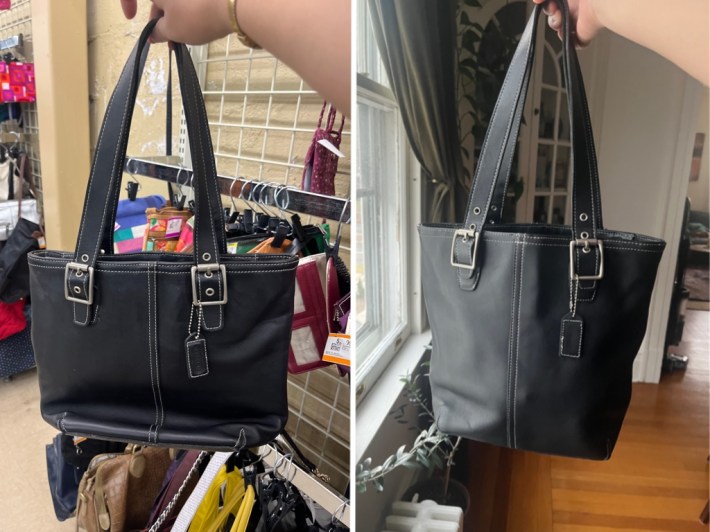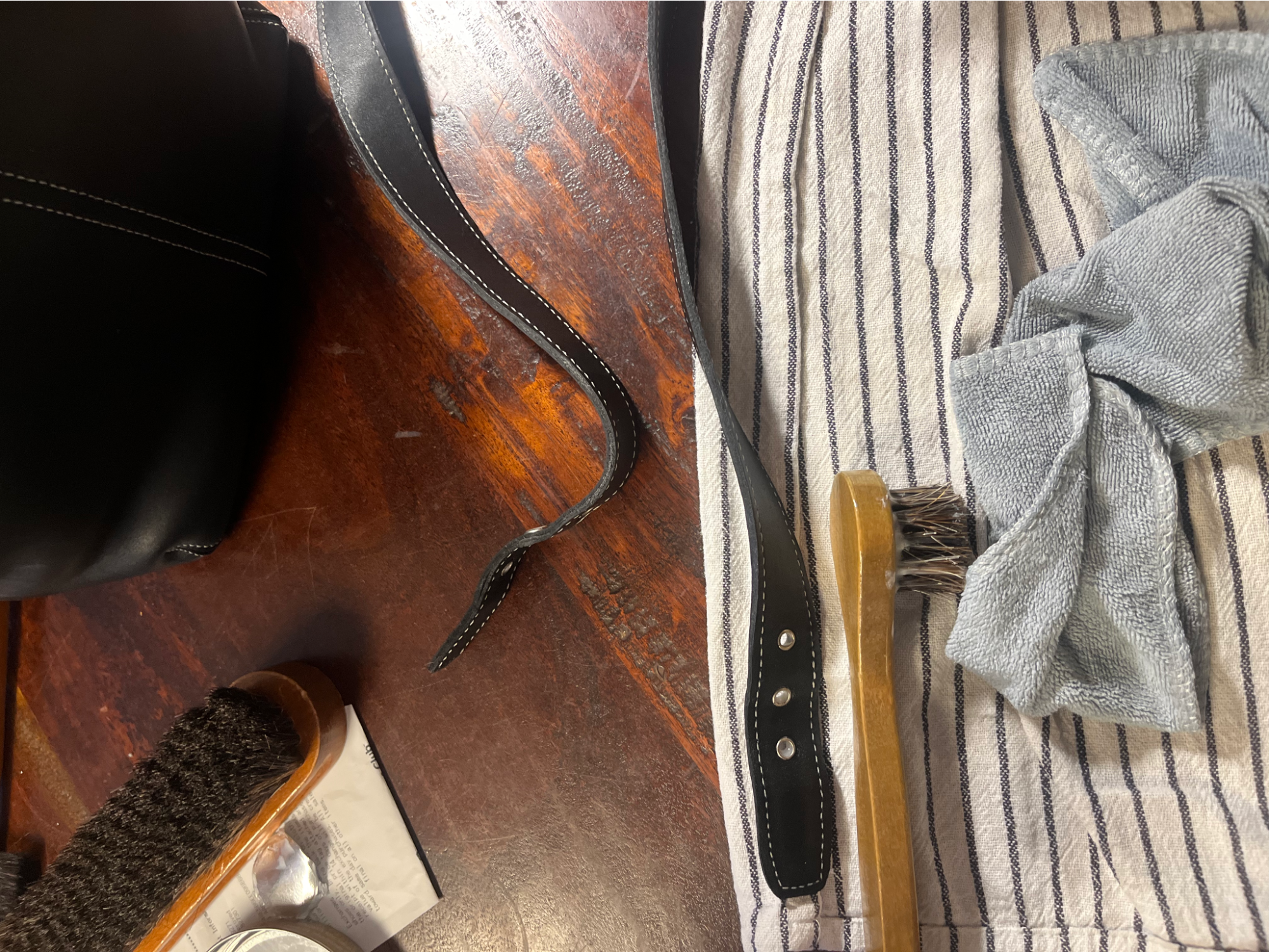Historically, I have not been a purse girl. Purses conjure a fussiness, a high maintenance that I find deeply unappealing and embarrassing. For most of my adult life, I chucked my things into a dirty canvas tote and called it good. In the wintertime, I often go purseless because I can stash my wallet, phone, and keys in my coat pockets just fine. Purses felt unnecessary, too in-the-way and fiddly for the life I lived. I would like to say my aversion to purses was only about practicality and function, but there was more than a little internalized misogyny at play, too.
Two months ago, a video came up on my TikTok feed of a man finding a vintage Coach purse at a thrift store and then spending several days cleaning and restoring it. In a voiceover, he talked about the bag’s history while he cleaned and conditioned the leather. He scrubbed every inch of the bag with saddle soap and a horsehair brush, then applied several layers of leather conditioner. In each gesture, I could see the care he took in restoring the bag. It was slow, meticulous work, and the result was stunning.
The finished product didn’t look new—it looked better than new. The leather’s patina shone through, and the bag went from dry, scratched, and neglected to shiny and supple. It looked like something that had been made to last, and now that it had been cared for appropriately, it would continue its long life.
After an hour of watching more videos on his account, I was hooked. I searched “vintage Coach restoration” and mainlined that shit for days. I learned to recognize the shapes of classic vintage Coach bags and I learned what collectors look for when they’re authenticating one. I learned how to read the serial numbers to tell when and where the bag was made, and I fell in love with a particular model (a red Ergo #9033, drool) that I haven’t seen anywhere for less than $250. I learned about Goodwill Auctions and Japanese eBay and spent hours on Facebook Marketplace, Depop, Vinted, and Poshmark looking for bags to rehab.
I fell in love with the process of rehabilitating Coach bags not because I am interested in designer fashion, but because learning about the history and craftsmanship behind them was so enticing. I realized pretty quickly that I didn’t just want to own a vintage Coach bag. That would be easy enough if I felt like dropping a couple hundred dollars on a purse, but as an avowed anti-purse girl, that made absolutely no sense. The satisfaction for me came from investing time and care into a previously loved, cast-off item to give it a second life.
Coach was founded in 1941 in New York and initially manufactured leather wallets, then handbags. It made a name for itself selling high-quality, durable products, but it wasn’t until Bonnie Cashin was hired as a designer in 1962 that the brand started to stake a strong point of view. If the Coach I know from the aughts was characterized by fabric bags emblazoned with its C logo, the coveted designs that built the brand are from the '60s and '70s.
Cashin incorporated bright colors in the leather as well as the fabric lining of the bags, and introduced features that would come to be recognized as iconically Coach, namely "kiss lock" coin purse closures and the turnlock, inspired by the latches on the removable roof on her sports car. My favorite Cashin designs have a prim ladylike aesthetic, with just a hint of irreverence that feels just as relevant to life today as in the 1960s. These were bags that traveled to grocery stores on the arms of housewives and consciousness-raising meetings on the arms of newly radicalized feminists. If you could afford one, a Cashin Coach could accompany you as you became whatever woman you wanted to be.
I spent a couple weeks popping into thrift stores on the weekends before I found the bag I would bring home. There were tons of 2000s-era fabric bags, but I was looking for 1990s or earlier, specifically in leather. One Saturday, I stopped in at a Savers and made an amazing find for $6.99.
The shape, contrast stitching, and silver grommets all seemed like good signs. I saw the leather hangtag and the creed inside, the serial number indicating it was manufactured in November 1994. If it wasn’t real, it was a good fake that would be perfect to practice my new hobby. And if it was real, then I’d just scored a 30-year-old bag for seven bucks.

I already had the necessary supplies—saddle soap, leather conditioner, microfiber towels and a few horsehair brushes—so I was ready to get started once I got home. I cleaned off the surface grime and thrift-store smell, but the real magic happened when I started moisturizing the leather. I removed the straps to clean them, and because they were so old and dry, they held their shape pretty rigidly. After one coat of Leather CPR conditioner, they had softened considerably and were shiny and supple.
Since getting into vintage Coach restoration, I’ve become such a handbag girlie, which is a turn of events I’m not sure I ever could have predicted for myself. I have thought a lot about the fact that a man’s TikTok praising the history and craftsmanship of Coach bags is what made me feel like this was a worthwhile way to spend my time, and I wonder if I would have given it the same attention if a woman’s voice had been my first exposure to this world.
For as long as I can remember, my relationship with many feminine-coded things has been fraught, not because I have mixed feelings about the things themselves, but because of what they represented. I remember being around 10 years old and hearing my dad say with pride that I was the kind of girl who read books instead of wasting time in front of the mirror. That brief moment echoed in my head for years against the constantly changing backdrop of American cultural attitudes toward femininity, feminism, and women in general. I would be a girl, but not that kind of girl. I would be a serious girl, the exception to the rules, never too distracted by her reflection to make a quick comeback or keep up with the boys. I would be the most palatable kind of girl: the kind who subjugated her femininity as much as possible. If I did that, maybe I would be safe from the contempt toward all things feminine I had begun to sense in the world around me.
Learning more about the history and craft of fashion has given me permission to show an interest in my clothing that I had previously written off as too girly for someone who wanted to be taken seriously. This journey coincided with a personal reckoning with my relationship to patriarchy. I came of age during the height of girlboss feminism. Anne-Marie Slaughter’s “Why Women Still Can’t Have It All” and Paulette Perhach’s “A Story of a Fuck Off Fund” rocked my world in my early twenties. I braced for adulthood and the pay gaps and relationship inequities it would bring. I was the first woman in my matrilineal line to graduate from college and pursue a career outside the home to follow my passions, and I felt the weight of generations of unachieved dreams on my shoulders at all times. I was not going to waste the opportunities I’d been given; I was going to go all the way, whatever that meant.
I would like to tell you that my fear was for nothing, that I braced for a blow that never came. But it came, again and again. I made less than my male peers, I was treated like a silly girl at work, and I was subjugated and coerced in multiple relationships in ways that have left me fearful and suspicious of men. I am still untangling the consequences of that harm, but in the meantime, I have married a kind and gentle man who makes me feel safe, who roots for my success, and who doesn’t look down his nose at my interest in The Bachelor franchise.
I have begun to question my fears, not because they aren’t valid, but because I’ve started to see how they hold me back in terms of how vulnerable I allow myself to be with my partner, and in seemingly insignificant ways as influencing how I dress. For so long, I have associated femininity with danger, with being vulnerable to being dismissed on good days, and to the threat of—or actual—violence on bad days. That’s the complicated thing. I'd like to say that all these defenses were for nothing, but that is not true. They protected me, but I don’t need them to protect me all the time. So I have cautiously taken steps toward softness, baring my most vulnerable parts to the air and exposing myself to the possibility of being hurt or caressed. That is the risk of vulnerability, but also the reward. In the process, I’ve begun to reacquaint myself with things I’d considered off-limits. I see that in the way I interact with strangers out in the world. I realized I had developed an icy affect toward strangers in an effort to protect myself from advances from men shouting “nihao” at me. As I’ve been interrogating my relationship with vulnerability, I find myself interacting with strangers with a warmth that hadn’t been there before. I’m quicker to smile, to add a human comment to our interaction, and to wish them a good day before we part ways.
Last weekend, a friend going through a hard time stayed over at our place and slept most of the day while their nervous system reset. My husband spent the day catching up on work, and I spent the day doing laundry, cleaning, and preparing food for both of them. I recognized that I was temporarily taking the form of a housewife, but it felt wonderful to be able to care for two people I loved on a day when they needed it, no reciprocity needed. Exposing yourself to hurt and betrayal is the necessary cost of intimacy, and there is no way to truly protect against it.
I still visit my secondhand websites and apps a couple times a week to check on new Coach inventory, but after seeing several designs get bid up several hundred dollars, I’ve accepted that the online marketplace isn’t where I’m going to find my diamond-in-the-rough treasure. It would be easier to find it online, but I realize I don’t want easy. I want to use what I’ve learned to spot my bag hanging on a crowded rack for less than $20. I want to see what it can be through the dust and grime and years of neglect, to bring it home and make it better than new.
Scars, like scratches on leather, show what you’ve lived through. Your scars are evidence of how life shaped you, but they don’t have to define your future. They can be a fatal flaw or a patina, depending on how you respond. You'll never be new again, but you can still be treasured.






